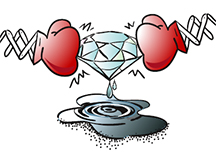
Instead of transmuting lead to gold using chemicals and spells — the dream of alchemists of old — Z-machine shockwaves have melted diamond to a liquid and turned it ultimately into graphite powder.
Romantically a waste, perhaps, but the unusual experiments had a high purpose: To quantify the response of the very rigid material to extreme pressure. This knowledge will enable researchers to set conditions under which diamond could best serve as a shell for fuel capsules of deuterium and tritium. Enhanced performance of these capsules could achieve better weapons simulation data and, ultimately, energy production through controlled nuclear fusion.
The experiments were also done in a rush — just before Z closed for a year-long renovation — at the behest of researchers at Lawrence Livermore National Laboratory’s National Ignition Facility.
LLNL researchers wanted information on the best material to encapsulate tiny targets to be struck by NIF’s powerful laser beams. These, when fully up and running, are expected to evenly compress a pellet so that its content of deuterium and tritium, would fuse to create neutrons — a key indication of fusion.
Researchers at Z are similarly interested in a better pellet envelope, since the refurbished, more powerful Z machine will use X-rays to also compress deuterium pellets in an attempt to raise the bar on its own nuclear fusion efforts, which two years ago produced fusion neutrons.
But diamond — one of the most rigid of materials — might seem an unlikely material for compression. Why not, say, a casing of easily malleable plastic?
Compression, it turns out, is not an issue. “At the pressures we’re interested in, [millions of times that of the atmosphere at sea level ] everything is compressible,” says Mark Herrmann (1674), who designed the capsule. “We want a capsule ablator [shell] with a low atomic number [like carbon, the element of which diamond is made] because they are good absorbers of radiation and are very dense.”
The ability to absorb a lot of radiation and not re-emit it means that most of the X-rays (produced by NIF or Z) that hit the fusion capsule will be absorbed and cause the dense interior of the diamond shell to rocket inward, compressing the deuterium-tritium mix.
Also, “Synthetic diamond is structurally strong and very uniform,” says theoretician Mike Desjarlais (1674). The casing thus is less likely to cause unequal pressures, producing perturbations that would fatally weaken the desired reaction.
“We want to create an equation-of-state model from what we learn about the diamond melt and then provide it to designers of ICF capsules,” says principal investigator Marcus Knudson (1646), who ran the experiments at the Z facility. (ICF is an acronym for Inertial Confinement Fusion, a method that forcefully compresses pellets to achieve nuclear fusion.)
In these experiments, tiny, magnetically propelled flyer plates impacted samples of artificial diamond to create the extreme pressures required. The plates, powered by Z’s intense magnetic field, flew a few millimeters at a speed of about 20 times that of a rifle bullet. They then slammed into test sheets of the thin, artificial diamond. By varying the velocity of the disks and analyzing the results, Marcus could determine when the pressure wave resulting from the impact traveled more slowly, as though it were passing through a liquid rather than a solid. He could translate this into the number of Mbars (millions of atmospheres) at which the liquefying process began.
Marcus’ search for the melt boundary was aided by Mike, whose work in advanced quantum-molecular simulations predicted an entry into the melted state at 6.9 Mbar, and completion of melt by 10.4 Mbar.
Marcus found that Mike’s figures were right on the money: Diamond begins to melt under shock-induced compression at about 6 to 7 million times greater pressure than exists at sea level.
The program also predicted a complete melt at over 10 Mbars, which also appears to be consistent with Marcus’ measurements.